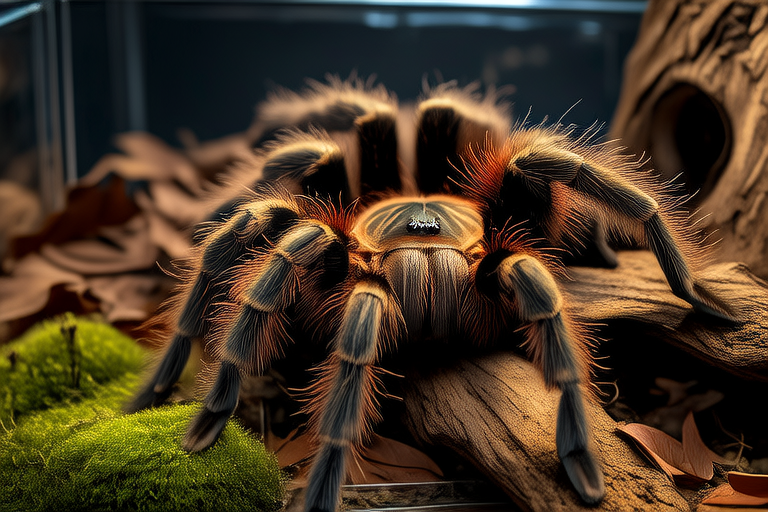Debunking Myths About Living With a Tarantula as a Pet
Tarantulas make fascinating and relatively low-maintenance pets for those interested in arachnids. These large, hairy spiders come from various habitats across the globe, each species offering unique traits. From the arboreal pink toe tarantula to the terrestrial Mexican red-knee tarantula, these creatures have captivated enthusiasts with their intriguing behaviors and manageable care requirements. However, many misconceptions surround tarantulas, deterring potential owners and causing unnecessary fears. This article aims to dispel eight common myths about living with a tarantula, providing accurate information and practical advice.
Myth 1: Tarantulas Are Aggressive
Myth: Tarantulas are aggressive and will attack humans at any opportunity.
Fact: Tarantulas are generally docile and only bite when provoked or threatened. Their primary defense mechanism involves releasing urticating hairs from their abdomen, which can irritate skin and eyes. Bites from most species are mild, comparable to a bee sting, and are used as a last resort. The Brazilian wandering spider is an exception but is not commonly kept as a pet due to its venomous nature.
Advice: Always handle your tarantula gently and respect its space. Avoid sudden movements and ensure your hands are clean and free of strong odors that might alarm the spider. With proper handling techniques, interactions can be safe and enjoyable.
Myth 2: Tarantulas Are Easy to Care For
Myth: Tarantulas require minimal care and can thrive in any environment.
Fact: While tarantulas are hardy creatures, they still need specific environmental conditions to thrive. Each species has particular habitat preferences, including temperature, humidity, and substrate. For example, the Chilean rose tarantula prefers a dry environment, while the Costa Rican zebra tarantula thrives in higher humidity.
Advice: Research the specific needs of your chosen species before bringing one home. Invest in appropriate enclosures, heating, and lighting equipment. Regular maintenance, such as cleaning the enclosure and monitoring environmental conditions, ensures your tarantula’s well-being.
Myth 3: Tarantulas Only Eat Live Insects
Myth: Tarantulas must eat live insects to survive.
Fact: Many tarantulas can be fed dead prey items, reducing stress and risk for both the spider and feeder insects. Pre-killed crickets, mealworms, and dubia roaches are suitable options. Some species may prefer live food initially but can adapt to pre-killed over time.
Advice: Introduce pre-killed feeders gradually to encourage acceptance. Ensure the prey items are appropriately sized—too large can cause digestive issues, too small may not provide adequate nutrition. Consult experienced breeders or veterinarians for feeding recommendations specific to your tarantula’s species.
Myth 4: Tarantulas Need a Lot of Space
Myth: Tarantulas require large enclosures to move around freely.
Fact: Tarantulas do not need extensive space; most species are sedentary and spend much of their time resting in one spot. An enclosure measuring approximately 10 gallons (37 liters) provides ample room for most adult tarantulas. Arboreal species benefit from taller enclosures with climbing structures, while terrestrial species prefer wide, shallow tanks.
Advice: Choose an enclosure size based on your tarantula’s species and age. Provide hiding spots, such as cork bark or silk plants, to mimic natural environments and reduce stress. Proper ventilation is crucial to maintain optimal air circulation.
Myth 5: Tarantulas Interact Frequently With Owners
Myth: Tarantulas are interactive pets that enjoy frequent handling.
Fact: Tarantulas are solitary animals and do not seek social interaction. They are primarily nocturnal and spend much of their day resting. Handling should be limited to necessary tasks, such as feeding or cage maintenance, to avoid stressing the spider.
Advice: Observe your tarantula from a distance to appreciate its behavior. Limit handling to brief periods and always support the spider’s body fully to prevent injury. Use tools like tongs or soft nets if you need to move the tarantula within its enclosure.
Myth 6: Tarantulas Have a Short Lifespan
Myth: Tarantulas only live a few years.
Fact: Many tarantula species have impressive lifespans, often exceeding a decade. Females typically live longer than males, with some species reaching up to 30 years. The average lifespan varies depending on the species and care quality.
Advice: Provide consistent care throughout your tarantula’s life to maximize its longevity. Regular health checks and prompt attention to any unusual behavior can help identify and address potential issues early.
Myth 7: Tarantulas Are Prone to Health Issues
Myth: Tarantulas frequently suffer from health problems.
Fact: With proper care, tarantulas are relatively healthy pets. Common issues include mite infestations, dehydration, and improper shedding. Mites can be introduced through feeder insects, so quarantine new additions to the diet. Dehydration can occur if humidity levels are too low, while inadequate shedding may result from poor nutrition or environmental factors.
Advice: Maintain a clean and well-regulated environment. Monitor humidity and temperature regularly. Offer a varied diet to ensure balanced nutrition. Seek veterinary assistance if you notice signs of illness or distress.
Myth 8: Tarantulas Are Expensive Pets
Myth: Tarantulas are costly to own.
Fact: Tarantulas are affordable compared to many other pets. Initial setup costs include purchasing an enclosure, heating devices, substrate, and a hygrometer. Once established, ongoing expenses consist mainly of food and occasional maintenance supplies. Some species, like the Chilean rose tarantula, are particularly economical.
Advice: Plan your budget carefully, factoring in all necessary equipment and supplies. Consider joining local reptile and amphibian clubs or online forums to connect with fellow enthusiasts who can share resources and tips.
A Positive Outlook on Tarantulas as Pets
Living with a tarantula can be a rewarding experience for the right owner. These unique creatures offer opportunities for learning about biology, ecology, and responsible pet ownership. By understanding their specific needs and respecting their nature, you can create a harmonious environment where both you and your tarantula can thrive. Embrace the challenge of caring for a tarantula with patience and dedication, and you’ll find yourself part of a dedicated community of passionate spider enthusiasts.
